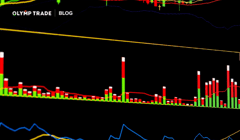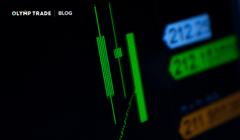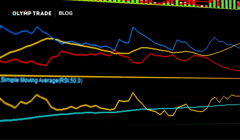
Some traders rave about how easy it is to use the RSI indicator, as it’s associated with saturated price patterns and price descriptions that can be seen as low or high limits during a trend. But is it true that using the RSI indicator is that easy?
Contents:
- What is the relative strength index?
- Reading RSI
- Using RSI to determine trends
- Limitations of RSI
- Сonclusions
Interact with the underlined words and green dots to get additional details and explanations.
Additional context for the visuals.
Explanations and definitions of terms.
What is the relative strength index?
The relative strength index (RSI) is a technical analysis indicator that traders use to measure the speed at which an asset’s price is moving. This indicator is also used to evaluate whether the asset is in an overbought or oversold position.

The RSI indicator is displayed as an oscillator with values ranging from 0 to 100. It was originally developed by J. Welles Wilder Jr. and introduced in his 1978 book New Concepts in Technical Trading Systems. This indicator is widely used by traders and technical analysts all over the world. The RSI measures the change in an asset’s price over 14 periods (14 days for the daily chart, 14 hours for the hourly chart, etc.).
Reading RSI
J. Welles Wilder Jr. believed that an asset has excessive buying interest if it reaches a value of 70 on the RSI indicator.
This means that traders should consider selling the asset when the indicator is at that value. On the other hand, when there is excess selling interest at or below 30, the trader should consider buying the asset.

The market is considered oversold if the RSI is below 30, and is considered overbought if the RSI is above 70. In general, the RSI is used to look for buy and sell signals in conjunction with other indicators. A sell signal is given when the RSI has entered the overbought area, whereas a buy signal is given when the RSI has entered the oversold area.


A sell signal confirmation is given when the RSI drops from the overbought area and is below 70, while a buy confirmation is given when the RSI rises from the oversold area and is above 30. However, it should be noted that not all overbought and oversold signals will end in a long reversal. More often than not, the price will continue upward or downward along the prevailing trend.
Although the default setting for the RSI indicator is a period of 14, traders can choose to modify it to increase the sensitivity of a shorter period or decrease the sensitivity of a longer period. In most cases, the seven-day RSI tends to be more sensitive to price movements than the 21-day RSI.
Despite its usefulness, the RSI is most rewarding when used together with other technical analysis indicators. Usually, it’s often paired with the moving average convergence divergence (MACD) indicator.
Using RSI to determine trends
When using the RSI, trading is benefited, as the indicator detects when a trend will change. The beginning of this change can be detected by looking at breakouts at key technical levels in the market.
In viewing or determining trends, traders usually use moving averages or channels. However, other technical indicators can be used as a guide as well, such as Aroon and Heikin-Ashi candles.

RSI has its own way of determining a trend. Pay attention to the level 50 and consider it a threshold. If the RSI signal is above 50, then the trend is going upward, while if it is below 50, then the trend is going downward.
In addition to determining trends, the 50 level can also indicate an early sign of a trend change. This can be marked by a break of the 50 level and is commonly known as the Centerline Crossover, or a break of the middle line with the RSI signal.
Limitations of RSI
The RSI is an indicator that compares bullish and bearish price momentum and displays the result in an oscillator that can be placed below the price chart.
As with most technical indicators, RSI signals are most reliable when adjusted for the long-term trend of an asset’s price movements.
Reversal signals, however, are relatively rare. This makes analysis with the RSI difficult because it does not provide precise information. Sometimes, traders or investors are faced with false RSI signals, which may cause fakeouts, or when traders buy or sell assets at the wrong time due to a lack of precision in the RSI’s calculation.
Because the indicator displays momentum, the RSI indicator can also continue to display an overbought or oversold phase over a long period of time. This is another use for the RSI: stock market trading in an oscillating market. That is, when the market faces a significant wave of price movement, where asset prices alternate between bullish and bearish moves.
Сonclusions
Now you know how to use and interpret the RSI indicator’s signals correctly. The relative strength index greatly adds to any trader’s analytical process. To get the maximum benefit from its use, RSI must be correctly combined with other methods of technical analysis. If you’re ready to move on to learning how to apply this and other tools to your decision-making process, we recommend delving deeper into trendline strategy and trading on simple chart patterns.
You can learn more about the RSI indicator at the Olymp Trade Help Center.
Join the Olymp Trade family to gain invaluable trading experience. We provide free trading education right here on the blog, with articles covering everything from Bollinger Bands to blockchain and everything in between. Whether you’re a beginner or a professional, know that Olymp Trade is your beacon in an ocean of financial opportunity.
Go to Olymp TradeRisk warning: The contents of this article do not constitute investment advice, and you bear sole responsibility for your trading activity and/or trading results.
A technical analysis tool that uses certain algorithms to analyze price performance and suggest its interpretation.
The overall direction of a market or an asset’s price.
When an asset is trading at a value higher than it is actually worth.
When an asset is trading at a value lower than it is actually worth.
A chart indicator that helps determine overbought or oversold conditions in ranging or non-trending markets.











